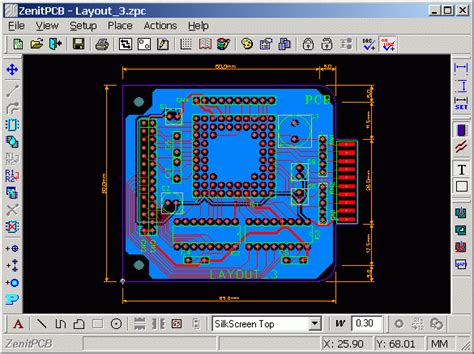Types of PCB design software
There are several types of PCB design software available, each with its own features, capabilities, and target users. Some of the main categories include:
Desktop PCB Design Software
Desktop PCB design software are standalone applications that run on a local computer. They offer a comprehensive set of tools for schematic capture, board layout, and manufacturing file generation. Examples include:
| Software | Vendor | Key Features |
|---|---|---|
| Altium Designer | Altium | Integrated schematic capture and board layout, 3D modeling, simulation |
| OrCAD | Cadence | Schematic capture, PCB layout, signal integrity analysis |
| EAGLE | Autodesk | Schematic editor, board layout, extensive component libraries |
| KiCad | Open Source | Free and open-source, schematic capture, PCB layout, 3D viewer |
Cloud-Based PCB Design Software
Cloud-based PCB design software are web applications that allow users to design PCBs using a browser, without the need for local installations. They often provide collaboration features and access to shared libraries. Examples include:
| Software | Vendor | Key Features |
|---|---|---|
| Upverter | Altium | Browser-based schematic capture and PCB layout, version control, collaboration |
| EasyEDA | EasyEDA | Online schematic editor, PCB layout, simulation, and manufacturing services |
| CircuitMaker | Altium | Free, community-driven PCB design platform with collaboration features |
Specialized PCB Design Software
Some PCB design software are tailored for specific applications or industries, such as high-speed digital design, RF and microwave design, or flexible and Rigid-Flex PCBs. These tools often include advanced features and simulation capabilities. Examples include:
| Software | Vendor | Key Features |
|---|---|---|
| Mentor Graphics HyperLynx | Siemens EDA | High-speed PCB analysis and optimization |
| Ansys HFSS | Ansys | 3D electromagnetic simulation for RF and microwave design |
| Zuken CR-8000 | Zuken | Multi-board PCB design, advanced packaging, and 3D modeling |
Key Features of PCB Design Software
Modern PCB design software offer a wide range of features to streamline the design process and ensure high-quality results. Some of the essential features include:
Schematic Capture
Schematic capture tools allow designers to create electronic schematics by placing symbols, drawing connections, and defining component properties. They also support hierarchical design, multi-sheet schematics, and electrical rule checking (ERC).
PCB Layout
PCB layout tools are used to arrange components, route traces, and define board stackup and geometry. They offer interactive routing, autorouting, design rule checking (DRC), and manufacturing file generation (Gerber, drill files, BOM).
Component Libraries
PCB design software include extensive libraries of schematic symbols and PCB footprints for various components. Users can also create custom libraries or import them from component vendors.
3D Modeling and Visualization
Many PCB design software now offer 3D modeling capabilities, allowing designers to visualize the board and components in 3D space. This helps in identifying mechanical interferences and optimizing component placement.
Simulation and Analysis
Advanced PCB design software integrate simulation and analysis tools to help designers evaluate signal integrity, power integrity, electromagnetic compatibility (EMC), and thermal performance. This enables early identification and resolution of potential issues.
Collaboration and Version Control
Some PCB design software, particularly cloud-based ones, offer collaboration features that allow multiple users to work on the same project simultaneously. Version control helps manage design revisions and track changes.
Choosing the Right PCB Design Software
When selecting a PCB design software, consider the following factors:
- User skill level and experience
- Project complexity and requirements
- Available features and capabilities
- Compatibility with existing tools and workflows
- Pricing and licensing models
- User community and support resources
It’s also a good idea to evaluate multiple options, try out free trials or demos, and seek feedback from experienced users or colleagues.

FAQ
Q1: What is the difference between schematic capture and PCB layout?
A1: Schematic capture involves creating an electronic schematic diagram that represents the logical connections between components. PCB layout, on the other hand, is the process of arranging components and routing traces on a physical PCB.
Q2: Can I use the same PCB design software for both simple and complex projects?
A2: While many PCB design software can handle a wide range of project complexities, some are better suited for specific types of projects. For example, a simple two-layer board may not require the advanced features of a high-end tool designed for multi-layer, high-speed digital boards.
Q3: Are cloud-based PCB design software as powerful as desktop applications?
A3: Cloud-based PCB design software have come a long way and now offer features and capabilities comparable to many desktop applications. However, they may have limitations in terms of customization, integration with local tools, and performance, especially for large and complex projects.
Q4: How important are component libraries in PCB design software?
A4: Component libraries are crucial in PCB design, as they provide ready-to-use schematic symbols and PCB footprints for a wide range of components. Having access to extensive and up-to-date libraries can save significant time and effort in the design process.
Q5: What should I look for in terms of simulation and analysis capabilities?
A5: The specific simulation and analysis features you need depend on your project requirements. Common capabilities include signal integrity analysis, power integrity analysis, EMC analysis, and thermal simulation. Look for tools that integrate well with your PCB design software and provide accurate results and actionable insights.
Conclusion
PCB design software are essential tools for creating high-quality, reliable printed Circuit Boards. With a wide range of options available, from desktop applications to cloud-based solutions and specialized tools, designers can choose the software that best fits their needs and budget.
When evaluating PCB design software, consider factors such as user skill level, project complexity, available features, compatibility, and pricing. It’s also important to assess the user community and support resources to ensure a smooth learning curve and timely assistance when needed.
By selecting the right PCB design software and leveraging its capabilities, designers can streamline their workflows, catch potential issues early, and ultimately create better products.

No responses yet